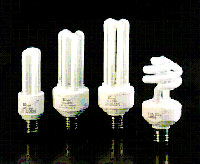Energy Efficient Lighting
A home's lighting system is both a large user of electrical energy (lighting consists of about 10% of your home energy bill) and is a major source of internal heat. Increasing your lighting efficiency is one of the fastest ways to decrease your energy bills.
 Compact
Fluorescent Light Bulbs
Compact
Fluorescent Light Bulbs
Recent technology has improved energy efficient lighting considerably with compact fluorescent light (CFL) bulbs. CFL bulbs have a phosphorus coating on the inner surface that converts UV energy into light.
Overall, CFLs use about 25 percent the amount of energy than regular incandescent light bulbs. By switching from a 100-watt incandescent bulb to a 26- or 28-watt CFL bulb you can save over 70 watts worth of energy and last up to 10 times longer. Also, because more of the energy of a fluorescent bulb is converted into light and less into heat, you are also saving on air-conditioning costs.

How to choose the right compact fluorescent bulb
Compact fluorescents cost a bit more initially but the long-term savings offset the initial difference in price.
There are 3 things to look for when selecting the right fluorescent bulb for your needs:
- Lumens - lumens measure light output, watts measure energy use. Bulb efficiency is measure by lumens per watt (LPW), calculated by dividing lumens by watts. The higher the LPW, the more light received for the energy used.
- CRI - color rendering index measures the perceived color of objects under artificial light. The higher the number, the more natural and vibrant colors will appear. Bulbs with a CRI of 80 or above are acceptable for everyday residential use.
- CCT - color correlated temperature measures how "warm" or "cool" a light seems. A low CCT (below 3100 K) is a warm white light.
Always compare brands for price, lumens, watts, CRI, and CCT. Be sure to read the label and see where the light can be used. Many are made for specific fixtures such as recessed cans, dimmer switches, or outdoor fixtures.
Outdoor lighting
Energy-saving bulbs are available for outdoor use as well. Again, always be sure to check the label to make sure the bulb and fixture are designed for outdoor use. Determine what activities will be happening in the lighted area and how much light you will need. Studies have shown that lower lighting reduces glare and helps homeowners to see their yards better at night than bright "security lights" which create deeper shadows and more hiding places.
- Motion sensors will turn the light on when movement is detected. In addition to saving energy, there is the added benefit of alerting you to activity in the area.
- Timers will automatically turn lights on and off according to the schedule you set.
- Photocell units respond to changes in natural light levels and will switch the lights on at dusk and off at dawn.
 Harmony is a Dark Sky City
Harmony is a Dark Sky City
To the maximum extent possible, lighting should be low intensity and conform to "dark sky" standards of downward projected, "full cut-off" illumination that shields light from being emitted upwards toward the night sky or surrounding natural areas. To be full cut-off, the light bulb should not extend below the lamp shade.
Be sure to check out regulations and town codes at the International Dark Sky Association or the Central Florida Astronomical Society. Contact Harmony staff for help in selecting a replacement outdoor fixture.
 When
changing lighting
When
changing lighting
- Select lamps that use energy-efficient (fluorescent) bulbs
- Install units carefully, following all the manufacturer's recommendations to reduce air leakage
- Do not throw CFL bulbs into the trash. contain mercury, so by simply throwing them in the garbage, the chance of groundwater contamination increases.
As energy-efficient lighting becomes more popular, it is important to dispose of CFLs safely and responsibly. When the time comes to replace a bulb, seal the old bulb in a plastic bag and take it to the South Bass Road Facility, 750 South Bass Road, Kissimmee.

